#today in airline history
Explore tagged Tumblr posts
Text
i learned that in 1987 —A guy bought a life time unlimited first class American Airlines for $250,000. He flew over 10,000 flights costing the company $21,000,000. They terminated his ticket in 2008.
It was 1981— and American Airlines were in deep shit needing some quick cash flow but interest rates were too damn high.
The new director of the company thought of what was a brilliant idea to sell a life time unlimited first class seat tickets that came with a companion ticket to who ever you want to bring along with for an extra $150,000 bringing the total to $400,000, with inflation in today’s money that’s would’ve been $1.2m— it was a bad idea*
The airline assumed that the buyers would use the ticket pass excessively but they failed to consider the super-travelers.
Steven Rothstein was one on the buyers of the ticket and boy did he use it so much that he would fly out to Paris for breakfast and lunch to dinner.

753 notes
·
View notes
Text
2 notes
·
View notes
Text
20 years ago today, I started pricing airline tickets to go see Just My Best Friend Who I'm Totally Not In Love With, Honest.
On September 20th, it'll be the 20th anniversary of our friends pretty much literally shoving us in a room and locking the door until we kissed.
Given that @urbanprole is asleep to my right, it seems like @reachmouse, @seananmcguire & all the rest of the people who'd undoubtedly gotten tired of our protestations of Just Best Friends did the right thing, there.

A couple weeks later, she flew to NC, and about 2 months after that, we got a dog.

The rest is history, as they say.
337 notes
·
View notes
Text
ASALA: Armenian Secret Army for the Liberation of Armenia (part 1)

In 1915, ottoman turkey committed the Genocide of Armenians: more than 1.5 million Armenians were massacred.
Women were assaulted, raped, sexually mutilated and tortured. Many were killed by bayoneting or died from prolonged sexual abuse. The “lucky ones” managed to kill themselves, while others were sold as slaves, forced to work as prostitutes or into marriage by their perpetrators. An eyewitness testified, "It was a very common thing for them to rape our girls in our presence. Very often they violated eight or ten year old girls, and as a consequence many would be unable to walk, and were shot."
The men were usually separated from the rest of “the deportees” during the first few days and executed, but, of course, not before being tortured and mutilated. Some were crucified, beheaded, others were often drowned by being tied together back-to-back before being thrown in the water. So many bodies floated down the Tigris and Euphrates that they sometimes blocked the rivers and needed to be cleared with explosives. Other rotting corpses became stuck to the riverbanks, and still others traveled as far as the Persian Gulf.
In 1918, the young turk regime took the war into the Caucasus, where approximately 1,800,000 Armenians lived under Russian dominion. Ottoman forces advancing through East Armenia and Azerbaijan here too engaged in systematic massacres. The expulsions and massacres carried by the nationalist turks between 1920 and 1922 added tens of thousands of more victims. By 1923 the entire landmass of Asia Minor and historic West Armenia had been expunged of its Armenian population. The destruction of the Armenian communities in this part of the world was total.
And yet, despite all of this—the unimaginable horrors that plagued the Armenian nation in the early 20th century—what do you think the world did in response? After this descent into hell, after the suffering, the bloodshed, the total annihilation—what followed? Silence. Deafening, shameful silence, as always.
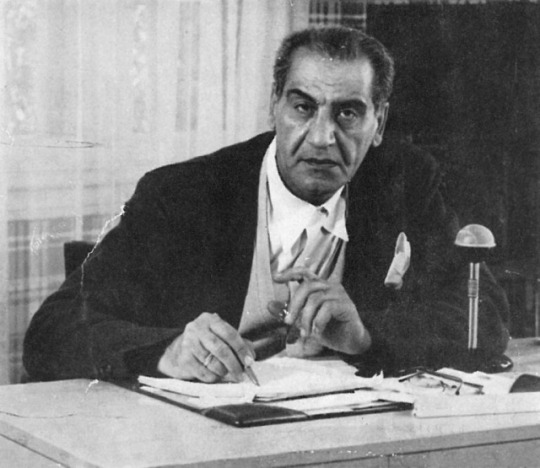
Silence—until it was shattered 58 years later, when, at the age of 78, having exhausted every peaceful avenue to draw the world’s attention to the Armenian Question and faced with nothing but ignorance, Gourgen Yanikyan fired 13 bullets at the Turkish consul and vice-consul. This singular act of defiance wiped 58 years of dust from the forgotten pages of Armenian history, forcing the world to confront the cause once again.By sacrificing his freedom, Yanikyan ignited a movement. His act became the catalyst for a wave of Armenian activism, inspiring the creation of ASALA, who would go on to fight for the recognition of the genocide.

In 1975, a group of Lebanese-Armenians led by Iraqi-Armenian Hakob Hakobyan, all of whose parents and/or grandparents were survivors of the genocide, inspired by Yanikyan’s self-sacrifice, decided to found an underground organization, which through armed actions will again bring the Armenian Question into the international political and legal dimension, present the recognition of the Armenian Genocide carried out by the turks in 1914-1923 by the international community, and create prerequisites for the liberation of Western Armenia. The organization was called ASALA - Armenian Secret Army for the Liberation of Armenia.
The military operations of the ASALA were mainly aimed at turkish embassies, consulates, diplomats, government officials, military and police institutions, the turkish business environment, especially the offices of "turkish airlines corporation", as well as the state and public structures of other countries, which showed financial or military support to the turkish state.
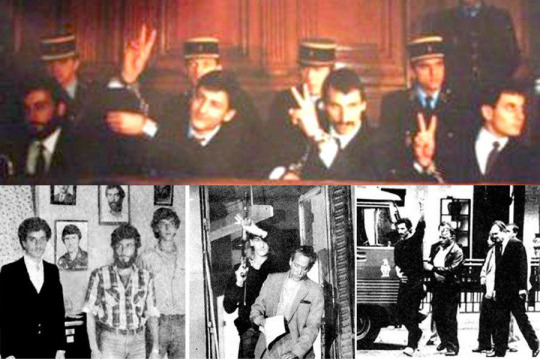
Now, why am I telling you about this today? Well, today - on September 24th marks the 43rd anniversary of the Van Operation (24/09/1981), carried out by 4 Armenian ASALA soldiers - Vazgen Sislyan, Hakob Julfayan, Gevorg Gyuzelyan and Aram Basmajyan. On this day in 1981, four Armenian youths, aged 20-24, armed with pistols, automatic rifles and explosives, seized the turkish consulate in Paris, holding it under their control for 15 hours.
youtube
4 Soldiers of The Van Operation taking off their masks
The trial of “VAN” turned into a trial of the turkish government. The “VAN” operation and the political trial that followed it played a major role in bringing the Armenian issue to the international political arena, globalizing the territorial claim and the violated rights of the Armenian people, creating a new wave of condemnation of the reality of the Armenian genocide, strengthening the pride and spirit of struggle among Armenians.
When all the hope has slipped away, It’s the mad who find a way.
Though violence is condemned, it is the cruel truth that it is the only language to which the world listens.
More about the Van Operation in the second part.
#break the chain of ignorance#armenian genocide#armenia#history#turkish crimes#azeri crimes#turkey#azerbaijan#asala#van operation#gurgen yanikyan#world politics#france#paris#september#baku gp 2024#cop 29#turkish tv series#translated literature#my translations#sorbonne
82 notes
·
View notes
Text
Seven thousand more UAW members just walked off the job, expanding the strike to two more plants. Twenty-five thousand autoworkers are now on strike, and the walkout could continue to escalate if the Big Three don’t budge in negotiations.
[UAW president Shawn] Fain announced that Stellantis would be spared this time. The union had been expected to strike all three companies, but, said Region 1 director LaShawn English, three minutes before Fain was scheduled to go on Facebook Live, the UAW received frantic emails from company representatives.
[Note: Love that for the UAW. Also laughing so hard. Three minutes before the next round of strikes were annouced!!]
According to Fain, Stellantis made “significant progress” on cost-of-living allowances, the right not to cross a picket line, and the right to strike over product commitments and plant closures. “We are excited about this momentum at Stellantis and hope it continues,” Fain said...
“See You Next Week — Maybe?”
“These guys wanted to go out a long time ago,” said Cody Zaremba, a Local 602 member at the Lansing GM plant after the news broke that his plant would be joining the strike. “We’re ready. Everybody, truly, I believe, in the entire membership. They’re one with what’s going on.”
Five thousand workers at thirty-eight parts distribution centers across twenty-one states have been on strike since last Friday [September 22, 2023], along with thirteen thousand at three assembly plants in Michigan, Ohio, and Missouri who walked out on September 15. (See a map of all struck facilities here.) ...
The UAW is now calling on community supporters to organize small teams to canvass dealerships that sell and repair Big Three cars and trucks. On Tuesday, the union issued a canvassing tool kit with instructions, flyers, press releases, and talking points.
In negotiations with Ford and GM, autoworkers have clinched some important gains. Among them is an agreement by both companies to end at least one of the many tiers in current contracts, putting workers at certain parts plants back on the same wage scale as assembly workers. The top rate for Big Three assembly workers is currently around $32...
Ford was spared in last week’s escalation, because bargainers there had made further progress on gains for workers.
But today, the UAW once again called out workers at Ford and GM, putting some muscle behind its bold demands — a big wage boost, a shorter workweek, elimination of tiers, cost-of-living adjustments tied to inflation, protection from plant closures, conversion of temps to permanent employees, and the restoration of retiree health care and benefit-defined pensions to all workers.
-via Jacobin, September 29, 2023. Article continues below.
Keep Them Guessing
This year, for the first time in recent history, the union has played the three auto companies against each other with its strike strategy, departing from the union’s tradition of choosing one target company and patterning an agreement at the other two.
The stand-up strike strategy draws inspiration from an approach known as CHAOS (Create Havoc Around Our System), first deployed in 1993 by Alaska Airlines flight attendants, who announced they would be striking random flights. Although they struck only seven flights in a two-month period, Alaska had to send scabs on every plane, just in case. The unpredictability drew enormous media attention and drove management up the wall. Meanwhile the union was able to conserve its strength and minimize risk.
The companies miscalculated where the UAW was going to strike first, stockpiling engines and shipping them cross-country to the wrong facilities. Autoworkers relished the self-inflicted supply chain chaos on UAW Facebook groups and other social media platforms.
Nonstrikers’ morale on the factory floor has gotten a boost from rank and filers organizing to refuse voluntary overtime. With support both from Fain and the reform caucus Unite All Workers for Democracy (UAWD), workers have been encouraging each other to “Eight and Skate,” meaning to turn down extra work and decline to do management any favors.
Majority Public Support
A majority of Americans support the UAW strikers, and the Big Three have taken a PR hit since the strike began, according to a new survey conducted by the business intelligence firm Caliber.
“Eighty-seven percent of respondents told us they were aware of the strike,” Caliber CEO Shahar Silbershatz told the Intercept. “It’s clear the strike is not just causing commercial repercussions, but reputational repercussions as well.”
These reputational repercussions will only worsen...
"We Can Unmake It"
Fain didn't pull any punches in his speech... “That’s what’s different about working-class people. Whether we’re building cars or trucks or running parts distribution centers; whether we’re writing movies or performing TV shows... we do the heavy lifting. We do the real work. Not the CEOs, not the executives.
"And though we don’t know it, that’s what power is. We have the power. The world is of our making. The economy is of our making. This industry is of our making.
“And as we’ve shown, when we withhold our labor, we can unmake it.”
-via Jacobin, September 29, 2023
#united states#us politics#organized labor#uaw#uaw strike#united auto workers#auto workers#labor rights#uaw strong#worker rights#unions#labor unions#strike#unionize#auto industry#ford#general motors#stellantis#working class#cars#michigan#ohio#missouri#solidarity forever#hot labor summer
466 notes
·
View notes
Text

He told his wife, "I love you," then left for work that morning. He never returned. It was September 11, 2001.
He was a husband. He was a veteran. He was an immigrant. And, he was a hero.
According to the Homeland Security web site, Rick Rescorla is credited with saving 2,700 lives that morning, when he defied official instructions to stay in the building and instead evacuated employees at his company on the 44th floor of the South Tower.
Another hero was Betty Ong, who was one of the flight attendants aboard American Airlines Flight 11, who gave vital information to the ground crew that eventually led to the closing of airspace by the FAA for the first time in United States history.
Flight 93 passengers Todd Beamer, Mark Bingham, Tom Burnett and Jeremy Glick fought their hijackers, preventing the plane from reaching its intended target, possibly the White House or the U.S. Capitol Building.
There were also 412 First Responders who died in the line of duty - 343 firefighters (including a chaplain and two paramedics) of the New York City Fire Department, 37 police officers of the Port Authority of New York and New Jersey Police Department, 23 police officers of the New York City Police Department, and 8 emergency medical technicians and paramedics from private emergency medical services and 1 patrolman from the New York Fire Patrol.
There were also smaller acts of bravery, such as Michael Benfante and John Cerqueira carrying a woman in a wheelchair down 68 floors of the north tower of the World Trade Center to safety and Frank De Martini and Pablo Ortiz of the Port Authority who saved at least 50 lives in the North Tower.
They and many others were the heroes of 9/11.
In all, there were 2,977 people who lost their lives on Sept. 11, 2001. The victims were mothers, fathers, sons, daughters, sisters and brothers who belonged to many faiths, races, and cultures, from more than 90 countries.
Of the Americans - they were white, they were black, they were brown, they were red, they represented all the different colors that built this nation. They were LGBTQ, they were straight, they were men, they were women, they were liberal, they were conservative, they were young, they were old . . . they were ALL Americans.
No one questioned whether they stood for the national anthem or put their hand over their heart, no one demanded they show their citizenship papers, no one questioned their love for their country.
I remember 9/11. I remember the names of the victims being read. I remember the heroes who bled. I remember the families who cried. I also remember that for one day, the entire world cried with us, marched in candlelight vigils in support of "America," whether it was in England or Iran -- for one moment the world was one.
I post this each year not just to remember the victims, the heroes, all the people who were directly touched in some way that day, but I also want to post this for those who are still suffering today, the families who had no choice but to continue without their loved ones, the veterans of the wars who were not supported upon their return and represent a majority of the suicides in this nation (on this World Suicide Prevention Day), the first responders who sacrificed their lives and their health and are still suffering today and their brothers and sisters fighting fires this very moment, and, most importantly, all the people of the world still hoping for, still seeking, still dreaming of a world without HATE, a world without fear, a world without greed.
A world instead focused with Love, a world with Hope, a world with . . .
Peace ~
The Jon S. Randal Peace Page
70 notes
·
View notes
Text
In just THREE DAYS, we have gotten:
Thursday: A DHC-8 in South Sudan that landed so hard it ripped off all of its wheels, forcing the pilots to abort the landing and successfully pull an emergency landing a few minutes later.

Friday: An ATR-72 in Brazil crashed after apparently entering into a deep stall, the final moments of the plane being captured in film by multiple people, becoming the first time in history that a commercial airliner caught in a flat spin was ever recorded
Saturday (today): A Cessna 152 flown by an Argentinian private pilot was intentionally crashed into an oxygen plant in the city of Rosario, after the disgruntled pilot was fired from it a day prior.

One hell of a wild and tragic week for aviation.
99 notes
·
View notes
Text
'Reise Reise' turns 20 today 💿🎶
20 years from today, on the 27th of September 2004, Rammstein's fourth studio album 'Reise Reise' was released in Germany, Switzerland, Austria and several other countries. It was most likely named after the old saying "Reise, Reise!" as a signal for the sailors of a sailing ship to get up.
Recordings of this album took place in the El Cortijo Studio in Málaga, Spain, where the band gathered in November 2003. Producer for this record was once again Jacob Hellner, and a making of about this recording process and the band's time in Spain was released on the 'Völkerball' DVD in 2006. During interviews for this documentary, the bandmembers expressed that this recording session seemed to be more relaxed than the last ones, and thought about several alternative names for this album - Schneider liked the title "Rot", Flake rooted for "Nein", Paul thought about "Amerika" and "Amore" as titles, Olli liked "Reise Reise" and Richard, a bit clueles, refrained from making a suggestion. Till apparently wasn't asked or declined talking about his ideas. Documentary parts with english subtitles can be found here, here and here.
The album was originally planned as a double album, but this idea was ultimatly discarded. The following songs were recorded during the session for this album, but were used on 'Rosenrot' later: Rosenrot, Wo bist du, Mann gegen Mann, Zerstören, Ein Lied, Feuer und Wasser and Hilf mir. Additional demos exist for the following: Absinth, Eisenmann, Holz und Sonntag bei Omi.
The promotional photosession for this album was done by Olaf Heine and most likely was inspired by the movie "Falling down", starring Michael Douglas.



The cover for this album shows the outside of a aircraft's blackbox with the German imprint "Flugrekorder nicht öffnen" ("Do not open flight recorder") on it. Linked to this design, there is a hidden track before the first song on REISE, REISE - it can be heard on standard CD players by rewinding. It features radio messages (the black box recording) from the Boeing 747SR (Japan Airlines Flight 123), which crashed on August 12, 1985, killing 520 people. Up to now, it remains the deadliest single-aircraft crash in history. This dark aesthetic of all of this combined also suits the song "Dalai Lama" on the album. This song is based on the German ballad "Erlkönig", written in the 18th century by Goethe, and for this song the first instrumental tracks were written and finished for this album.
The limited digipack contained a picture from the above mentioned photoshoot.
The Japanese cover of the album is the same one that was later used for Rosenrot, a picture of the ice breaker USS Atka in the Antarctic from 1960.



As part of the promotion for 'Reise Reise', three additional CDs were published with interviews of the band members. CD 1 contained an interview with Till and Flake, CD2 with Olli and Paul and CD3 with Richard and Schneider. The linked videos contain the original soundtrack with the german interviews and a spoken english translation.




Regarding the success of this album: REISE, REISE reached number 1 in the album charts in seven countries (Germany, Austria, Switzerland, Finland, Iceland, Estonia and Mexico). After the release of REISE, REISE, Billboard declared Rammstein to be the most successful German-speaking band internationally. The album achieved 1x silver, 3x gold and 6x platinum. The song 'Mein Teil' was nominated for a Grammy. All in all, Reise, Reise reached 47th place in the Top 50 album charts of 2005.
The Reise Reise tour started with one concert (September 30th 2004) at the Label showcase party "10 Jahre Motor" and marks the only acoustic concert the band has ever played. For the occasion, the band dressed up as East Berlin police women.



After that, three concerts at the Knaack club followed on the 11th, 12th and 13th of October, 2004, where the album was presented at fan club only concerts.



Two examples for tickets for the Reise Reise tour:


Sources: rammwiki, affenknecht, rammsteinworld, rammsteinblogcollection, metal-hammer, photo.sibnet
#rammstein#reise reise#an album which really has grown on me#i love researching this stuff#happy birthday reise reise 🤍#research & rammsplaining#interviews & quotes
66 notes
·
View notes
Text

Donald Trump has sent the federal government into a state of turmoil with his mass firings, flood of dubious executive orders, and appointments of alarmingly incompetent individuals. And when something goes wrong because of his own malfeasance, he resorts to flimsy scapegoating rather than accept responsibility.
A US Army helicopter collided with an airliner just a few days after a frequently drunk sex abuser picked by Trump became Defense Secretary.
At Daily Kos, Emily Singer writes about Pete Buttigieg's response to Trump's demented tirade about the crash.
Buttigieg then said Trump bears some of the blame for the crash, as he is in charge and has already taken actions to make the skies less safe. "President Trump now oversees the military and the [Federal Aviation Administration]," Buttigieg continued. "One of his first acts was to fire and suspend some of the key personnel who helped keep our skies safe. Time for the President to show actual leadership and explain what he will do to prevent this from happening again." At the time of the crash, there was no head of the FAA, as Trump's co-President Elon Musk had forced out the previous administrator because the FAA fined Musk's company SpaceX.
Yep, Elon Musk's billionaire ego may have contributed to the deaths of 67 people in this week's crash.
Trump also gutted an aviation safety committee days before the crash, getting rid of a three-decade-old safety committee that was created by Congress after the 1988 PanAm 103 bombing over Lockerbie, Scotland. Because the committee was created by an act of Congress, Trump couldn’t get rid of it, but he did fire all of its members, which will make the committee unable to do the work of looking into airline safety issues, the Associated Press reported. Kara Weipz, the president of Victims of Pan Am Flight 103, said a statement that Trump’s gutting of the safety commission, “will undermine aviation security in the United States and across the globe.”
Trump only cares about keeping oligarchs happy and himself out of prison. Public safety and health mean nothing to him.
Alexander Sammon at Slate writes...
t marks the first major crisis of the nascent Trump presidency, and one with particularly bad optics for the president. In his war with the administrative state and in his determination to gore federal spending, Trump had already fired the heads of the Transportation Security Administration and the Coast Guard and gutted a key aviation safety advisory committee, all just 10 days before the crash. As the Daily Beast reported, Federal Aviation Administration head Michael Whitaker stepped down on Jan. 20, after Elon Musk, the spear tip of Trump’s “cost cutting” spree, demanded that he quit.
Firing public safety officials so Elon Musk can play James Bond villain is the mark of a malicious moron, not a leader.
Trump doesn't have a great history with airplanes. He once had an airline called Trump Shuttle. One serious accident can be found in news archives.
Trump Jet Crash-Lands; No Injuries
Trump Shuttle lasted only three years and never made a profit. It sits on the shelf of Trump business failures along with Trump Vitamins, Trump Steaks, and Trump University.
A broader matter is the existence of Ronald Reagan Washington National Airport (DCA). It's directly on the other side of the Potomac River from Washington and suffers from congestion and understaffing. It probably shouldn't even be there but it's very convenient for politicians who prefer not to commute to the better equipped Dulles Airport.
USA Today says...
The airport is particularly popular among lawmakers because it's more convenient to their Capitol Hill offices than either Dulles International Airport (IAD) or Baltimore/Washington International Airport (BWI). [ ... ] "DCA is currently at capacity and at risk of being seriously overburdened should there be changes to the slot and perimeter rules," the Coalition to Protect America’s Regional Airports said in April. "Moreover, any changes to the slot and perimeter rules threaten to undermine the access of regional airports and their communities to the D.C. area, as well as increase delays, traffic, congestion, noise, and safety concerns." [ ... ] The airport's longest and main runway, Runway 1/19, is 6,869 feet long, which today is considered a relatively short runway for a major airport. Because the other two runways are much shorter, most airplanes use 1/19, making it the single-busiest runway in the country, according to airport officials. According to air traffic control data, Flight 5342 was on final approach for one of the shorter DCA runways, Runway 15/33. Due to safety and noise considerations, the FAA generally requires aircraft flying around the Washington, D.C., area to travel above the Potomac, which concentrates traffic in a narrow area. Aircraft are generally required to stay above or below certain altitudes in the area to reduce noise impacts on both residential and tourist areas, including the National Mall.
With fewer federal workers and reduced regulation which Trump and his filthy rich libertarian extremist broligarchs demand, expect more disasters.
#donald trump#maga#flight 5342#dca#ronald reagan washington national airport#faa#potomac plane crash#us federal government#pete hegseth#trump incompetence#trump malfeasance#trump shuttle#deregulation#firing federal workers#pete buttigieg
30 notes
·
View notes
Text
Tired of pretending airships shouldn’t make a comeback. “Oh but the Hindenburg” just use helium instead of hydrogen gas. “But they’re slow and expensive and not as efficient as planes” dude do you hear yourself. We live in a world dominated by cars. Trains are right there but we still use cars.
Hear me out, seriously. Right now you can book a flight with a shitty oligopoly airline company. From New York to LA, it takes six hours. You pay a ridiculous amount for ticket costs, and then a ridiculous amount more in fees. You get zero leg room. You get squeezed between two strangers. You only get up to use the bathroom or stretch your legs for a few minutes. If you leave your entertainment in your overhead luggage, you’re fucked, and you have to pay extra for headphones and wifi and shitty movies on a tiny little screen. All of that on, you know, a Boeing plane. The former pinnacle of safety.
Or you can book a ticket on an airship. It takes twice as long— 12 hours from New York to LA— but your day is being eaten up by travel time either way. You get a nice real table to set your stuff down at, and you can wander around the ship and look over the landscape as you cross the USA. You don’t have to worry about greenhouse gas emissions or your carbon footprint. You get ridiculously good photos for your instagram. Hell, you might even get to board the airship from the top of the god damn Empire State Building.
Maybe I’m just letting the autism win today, but all that seems like a pretty good trade off for a slower travel time. I’m not saying it should be the primary mode of travel for everyone everywhere. But I am saying it should be an option for travel, instead of just being a neat visual gag for parallel dimensions and alternate histories.
24 notes
·
View notes
Text
Thankful for class consciousness
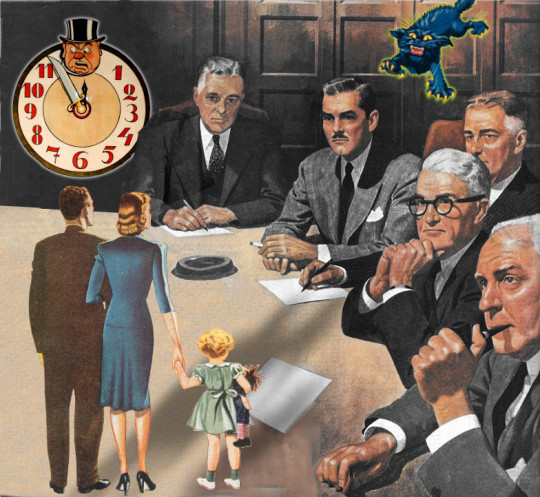
On November 27, I'm appearing at the Toronto Metro Reference Library with Facebook whistleblower Frances Haugen.
On November 29, I'm at NYC's Strand Books with my novel The Lost Cause, a solarpunk tale of hope and danger that Rebecca Solnit called "completely delightful."

Before the term "ecology" came along, people didn't know they were on the same side. You care about owls, I care about the ozone layer – what does the destiny of charismatic nocturnal avians have to do with the gaseous composition of the upper atmosphere?
But as James Boyle has written, the term "ecology" welded together a thousand issues into a single movement. When we talk about "looking at our world through a lens," this is what we mean – apply the right analytical lens and a motley assortment of disparate causes becomes a unified, coherent project:
https://scholarship.law.duke.edu/cgi/viewcontent.cgi?article=1013&context=dlj
Unfettered, planet-destroying, worker immiserating corporate power is only possible in the absence of such a lens. Before neoliberalism can destroy our lives, it must first convince us that we are all disconnected. "There is no such thing as society," isn't just an empty slogan: it's a weapon for dismantling the democratically accountable structures that can stand against industrial tyrants.
That's why neoliberalism is so viciously opposed to all kinds of solidarity, why corporate apologists insist that the only elections that matter are the ones where you "vote with your wallet." It's no surprise that the side with the thickest wallets wants to replace ballots with dollars!
Today, at long last, after generations of deadly corporate power-grabs, we are living through an ecology moment where all kind of fights are coalescing into one big fight: the fight to save democracy from oligarchy.
There are many tributaries flowing into this mighty river, but two of the largest are antitrust and labor. Antitrust seeks to ensure that our world is regulated by democratically accountable lawmakers who deliberate in public, rather than shareholder-accountable monopolists who deliberate in smoke-filled rooms. Labor seeks to ensure that contests between profit for the few and prosperity for the many are decided in favor of people, not profit.
This coalition is so powerful that the ruling class has never stopped attacking it. Indeed, the history of US antitrust law can be viewed as a succession of ever-more-insistent laws enacted solely to make it clear to deliberately obtuse judges that competition law is aimed at corporations, not unions:
https://pluralistic.net/2023/04/14/aiming-at-dollars/#not-men
Rising corporate power and declining worker power is bad for all of us. The failure of successive US administrations to block airline mergers led to sky-high prices and a proliferation of "junk fees" that can double the price of a ticket. The monopoly carriers stand to make $118b this year from these fees:
https://www.fastcompany.com/90981005/airlines-fees-118-billion-dark-patterns
The consolidation of the agricultural sector led to cartels that conspired to rig the prices of our food. These Les Mis LARPers rigged the price of bread!
https://www.cbc.ca/news/business/canada-bread-price-fixing-1.6883783
Remember eggflation? Nearly all the eggs in US grocery stores come from a single company, Cal-Maine, which owns dozens of brands, including "Farmhouse Eggs, Sunups, Sunny Meadow, Egg-Land’s Best and Land O’ Lakes eggs":
https://www.cnn.com/2023/01/13/business/egg-prices-cal-maine-foods/index.html
With all our eggs in one basket, it was easy for a single company to rig the egg market, blaming everything from bird flu to Russian invasion of Ukraine for doubling egg prices while their profits shot up by 65%:
https://pluralistic.net/2023/01/23/cant-make-an-omelet/#keep-calm-and-crack-on
Antitrust isn't just about monopoly – it's also about oligopoly. The American meat cartel pretends that it's not rigging markets by outsourcing its price-fixing to a "clearinghouse" called Agri Stats:
https://pluralistic.net/2023/10/04/dont-let-your-meat-loaf/#meaty-beaty-big-and-bouncy
Agri-Stats gets data from all the Big Meat companies, "anonymizes" it, and publishes it back to its subscribers, who use the service to coordinate across-the-board price-hikes that have cost the public billions in price gouging (meanwhile, Big Meat was able to secure $50b in public subsidies).
For forty years, governments have ceded power to "autocrats of trade" who usurped control "over the production, transportation, and sale of the necessaries of life":
https://pluralistic.net/2022/02/20/we-should-not-endure-a-king/
But that era is coming to an end. In the past year, American regulators have blocked airline mergers and promulgated rules banning junk fees. They've dragged price-fixing clearinghouses into court:
https://www.thebignewsletter.com/p/why-turkey-eggs-and-air-travel-just
They're getting results, too: for the second year in a row, turkey prices are down. Cranberries, too (18%). Same for whipping cream (25%). Pie crusts are down. So are russet potatoes. Airfares are down 13.2%.
The egg cartel just lost a long-running court case over the last egg price-fixing campaign, which gouged Americans from 1990-2008:
https://www.pymnts.com/cpi_posts/kellogg-kraft-secure-victory-in-price-fixing-lawsuit-against-egg-producers
The same fact-pattern that was revealed in that court case is repeated in this year's eggflation scandal:
https://farmaction.us/wp-content/uploads/2023/01/Farm-Action-Letter-to-FTC-Chair-Lina-Khan.pdf
That's terrific ammo for the FTC, and will doubtless benefit the Democrats running against would-be Indiana senator John Rust, whose family owns convicted egg cartel member Rose Acre Farms and whose wife just stepped down as chair of the board.
One underappreciated aspect of the global war on corporate power is that the same corporations commit the same crimes in countries all over the world, which means that whenever any government establishes evidence of those crimes, they are of use to all the other governments. Competition enforcers from the UK, EU, USA, Singapore, South Korea and elsewhere are coordinating to target the Big Tech cartel. Maybe Google and Facebook and Apple are bigger enough to resist any one of those governments – but all of them?
https://cmadataconference.co.uk/
One notable absence from the anti-monopoly coalition is Canada. While other countries merely stopped enforcing their competition laws in the neoliberal era, Canada never had a good competition law to enforce. Canada's official tolerance for monopolies has allowed a handful of companies to seize control over the economy of Canada and the lives of Canadians:
https://www.canadaland.com/shows/commons-monopoly/
These monopolies are largely controlled by powerful families, Canada's de facto aristocracy, whose wealth and power make them above the law and subordinate the country's democratic institutions to billionaires' whims:
https://www.canadaland.com/tag/dynasties/
At long last, Canada has called time on oligarchy. Last week's Fall Economic Statement included an announcement of a muscular new competition law, including new merger guidelines, a new "abuse of dominance" standard, and Right to Repair rules:
https://www.linkedin.com/feed/update/urn:li:activity:7132855021548769282/
The law also includes interoperability mandates for Canada's highly concentrated – and deeply corrupt – banking sector. These measures are strikingly similar to new measures just introduced in the US by the CFPB:
https://pluralistic.net/2023/10/21/let-my-dollars-go/#personal-financial-data-rights
The arrival of Canada's first fit-for-purpose competition rule coincides with all kinds of solidaristic movements in Canada that are fighting corporate power from the bottom up. Even Ontario, led by one of the most corrupt premiers in provincial history, can't break its teachers' union:
https://globalnews.ca/news/10105600/ontario-elementary-teachers-reach-contract-deal/
It's not just workers who benefit from solidarity: Tenants' unions have formed across the province in response to corporate takeovers of scarce rental stock. These finance-sector landlords have armies of lawyers who've figured out how to bypass rent-control rules and evict tenants who balk. Rather than rolling over, tenants' unions are organizing waves of rent-strikes:
https://macleans.ca/longforms/rent-strikes-canada/
As with Big Tech, the illegal tactics of the rental sector aren't confined to a single nation. In America, Wall Street landlords have dramatically increased the price of housing and kicked off an eviction epidemic the likes of which the country has never seen:
https://pluralistic.net/2023/05/16/mortgages-are-rent-control/#housing-is-a-human-right-not-an-asset
And as with Big Meat, landlords use arm's-length clearing houses to rig rental markets, coordinating across-the-board rent hikes:
https://www.propublica.org/article/yieldstar-rent-increase-realpage-rent
In other words: to fix the housing market, tenants all over the world need to learn the tactics of labor unions. Housing regulators have to learn from agricultural regulators. Americans tenants have to learn from Canadians. These aren't 1,000 different fights – they're one big fight, and the coalition for dismantling corporate power is vast and powerful.
The most powerful weapons our bosses have is convincing us that we are weak and they are strong – so strong that we shouldn't even try to fight them. But solidarity is absurdly powerful, which is why they go to such great lengths to discredit it. In Sweden, the solidarity strikes against Tesla – who refuses to recognize its maintenance workers' union – have spread to nine unions.
Tesla can't get its cars offloaded at the ports. It can't get its showrooms cleaned. No one will deliver its mail. No one will fix its chargers. The strike is spreading to Germany, and workers at its giant Berlin factory is set to walk out:
https://www.metafilter.com/201514/Swedish-Tesla-workers-go-on-strike
There's something delicious about how palpably frustrated Elon Musk is by all this, as he realizes that neither his billions nor his bully pulpit are a match for workers in solidarity:
https://www.bloomberg.com/news/articles/2023-11-23/elon-musk-calls-swedish-tesla-strikes-insane-as-impact-spreads
It's a reminder of just how fragile and weak billionaires are, when we stop believing in them and deferring to them. Rebecca Solnit's latest Guardian column adds up the ways that allowing billionaires to run the show puts us all in danger:
https://www.theguardian.com/commentisfree/2023/nov/20/billionaires-great-carbon-divide-planet-climate-crisis
They are the unelected "autocrats of trade" who control "the production, transportation, and sale of the necessaries of life." They are the force that this new ecology movement is coalescing to fight: across borders, across sectors, across identities. No matter whether you are a worker, a tenant, a voter, a shopper or a citizen, your enemy is the billionaire class.

If you'd like an essay-formatted version of this post to read or share, here's a link to it on pluralistic.net, my surveillance-free, ad-free, tracker-free blog:
https://pluralistic.net/2023/11/24/coalescence/#solidarnosc
#pluralistic#james boyle#ecology#corporate power#monopoly#monopolism#eggflation#euthanizing rentiers#money beats ethics#incentives matter#sam altman#open ai#junk fees#cartels#aviation#billionaires#rebecca solnit#price fixing#Rent strike#canada#canpoli#toronto#the rents too damned high#weaponized shelter#tenants union#unions#tesla#sweden#labor#moral injury
100 notes
·
View notes
Text
Ballad of a Gooney Bird
Gazing skyward, her tail-wheel configuration appears as if she's ready to fly—embracing the celestial world above, loving the heavens like her airmen within.

Pulling chocks from her wheels, line personnel scramble beneath her soft beautiful lines. Aerodynamic curves, waiting to serve her desires, a calling to the sky.
The calm before flight, interrupted by the captain's call, "Clear, right!" A signal to anyone nearby to remain clear of the right propeller.
Pressing the primer, starter, and vibrator switches to the right, the first officer watches as her three-blade propeller begins to rotate on the starboard engine. On the twelfth rotation, puffs of smoke pour from the exhaust as the C-47 rumbles to life—vibrating the entire airframe.
Quickly releasing the starter switch, the first officer keeps pressure on the remaining switches, monitoring the response from the engine. As the rumble transitions to a roar, he releases the vibrator switch while gently advancing the mixture lever, he continues to work the primer until her engine settles into a consistent hum.

Waiting for the signal from the captain, the first officer prepares to repeat the procedure on her left engine—accomplishing the same series of steps that would be repeated countless times through the decades prior to each flight.
Whether preparing for her daring airborne drops over Normandy; flying the Hump between India and China; to rescuing U.S. forces from the frozen world of North Korea; or supplying the Berlin airlift; the rumble of each engine start still echos through aviation history today.
While her civilian sister, the Douglas DC-3, would serve U.S. airlines, the C-47 Skytrain—sometimes referred to as Gooney Bird—operated as a military transport aircraft from WW2 to Vietnam. While so many other aircraft steal the spotlight, the U.S. C-47 played a major role in conflict, a role unmatched during her era of flight.
Even today, her DC-3 sister still rumbles off runways, serving poorer nations around the globe. A testament to superior aircraft design, a soft simple beauty only recognized by her airmen.
My photos: Douglas C-47 Skytrain Mott's Military Museum, Groveport, October 16, 2021.
By @aviationgeek71
#c 47 skytrain#avgeek#aviation#aviation history#history#my photography#my photo#my writing#original photography#original writing
34 notes
·
View notes
Text
No. 15 - PSA (Pacific Southwest Airlines)

Thank you to @lobstersinmyhouse for requesting PSA! And, in all honesty, this is exactly my feelings too. Pack it up, post over.
...okay, no. I am going to write a post, but I make no secret of loving PSA's airplanes. After all, one is even my icon.

image: Piergiuliano Chesi
There was never an airline like it before PSA sprang up in 1949, and there has never been an airline like it since. Decades after its demise I still feel a real sense of grief about the fact that it's gone. Pacific Southwest Airlines hasn't existed for longer than its entire time in operation and it mostly only operated in a single state, but it remains one of the most beloved airlines ever to exist. I'm certainly far from immune to catching their smile. So I'm very, very excited to cover the iconic grinningbirds, one of the best-known airline liveries of all time even 40 years after the regional carrier which wore it ceased existing.
youtube
PSA officially stands for Pacific Southwest Airlines. Unofficially, it was the Poor Sailor's Airline. According to a button they put out, it was this.
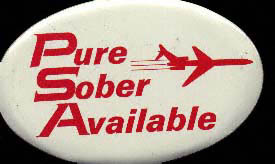
image: psa-history.org
But really, it can stand for anything you want. I think it stands for Pretty Smiling Airplanes.
You see, PSA's marketing leaned into the fun and casual as much as it was possible for an airline to do. They called themselves "The World's Friendliest Airline". Their branding was all bright, colorful, delightful. One aspect of it is particularly well known.
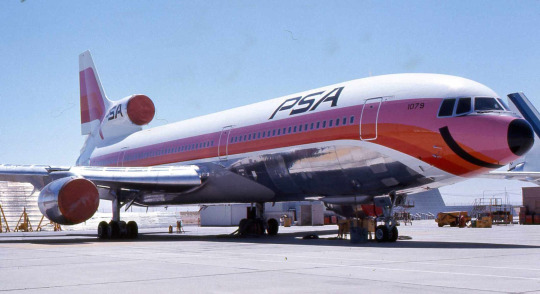
image: Piergiuliano Chesi
The name "grinningbird" is literal. PSA's fleet was lovingly painted with massive smiles directly under their noses. Their advertisements encouraged people to "catch our smile" across the state of California.

A preserved DC-3 in original Pacific Southwest livery
PSA was started as a single leased DC-3 hopping from San Diego to Oakland. Apparently their ticket office was literally a refitted military surplus latrine where they weighed passenger baggage on a bathroom scale. When they expanded with DC-4s they painted rectangles around the windows to make them look more like DC-6s. This was in 1955. And then, by the early 60s, they were taking off.
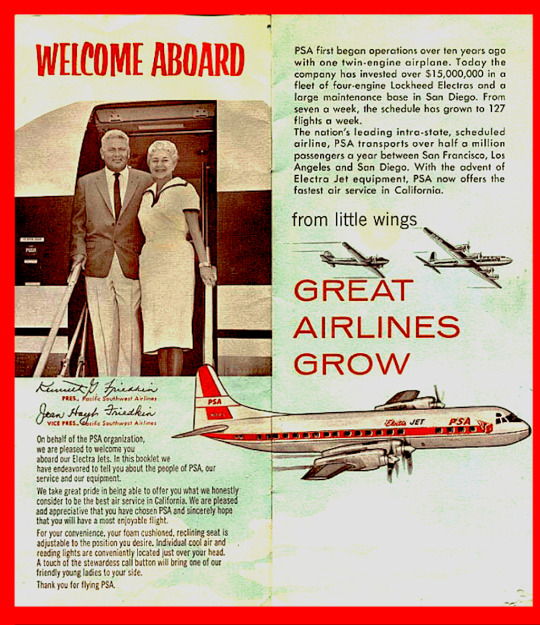

A pre-smile PSA Electra. The L-188 Electra is, of course, my favorite jet plane. image: Jon Proctor
It was in the 60s that their planes stopped saying 'Pacific Southwest Airlines' and started just being PSA, and it was in the 60s when they caught their smiles. This was the point when PSA became PSA, transforming from just another intrastate airline in the pre-deregulation era to a turning point in aviation history.
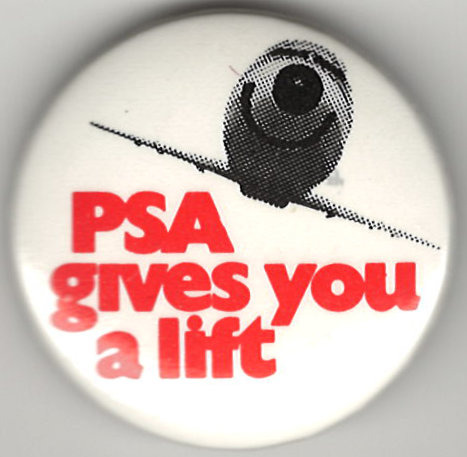
a 1972 promotional button image: psa-history.org
While the smiley faces are the most significant historical fact about PSA, also notable is the fact that they were the first low-cost carrier in history. Although PSA's routes were limited to Southern California, they charged $9.99 for a ticket other airlines would charge $13.50 or $22.05 for - and keep in mind that in today's money that's a difference of hundreds of dollars. Free of federal fare taxes and operating frequently, PSA grew at an intense pace with its new fleet of Lockheed L-188 Electras.

I love the L-188 Electra (not to be confused with the earlier L-10 Electra best known for Amelia Earhart reasons). Although Lockheed has long since moved over to exclusively making weapons for killing people, back when they were in the civil airliner market they made the most incredible planes which somehow ended up commercially flopping time after time. The Electra, for instance, was all but killed immediately by two early crashes caused by a sneaky design flaw. These were fixed, but the type's reputation had already been sullied. (Interestingly, similar early design flaws with far less prompt responses failed to kill either the DC-6 or the DC-10, despite the latter causing the deadliest crash in history at the time and the former having had the serious potential to give us a timeline where the President of the United States was killed because his presidential transport had a design flaw which encouraged going up in flames midair.) Ironically, the Electra is actually an insanely reliable and sturdy plane, and the example pictured is still in service as an air tanker under the registration C-GZCF, still doing her thing at just 63 years young. (Another Electra in Air Spray's fleet is a similar age but also survived being bisected across the belly by her own detached propeller, and she literally flew two days ago. These planes are on a level only shared with Nokia cell phones, especially for their size.)
That paragraph became about the Lockheed L-188 Electra. I did not mean for it to be, but I am leaving it in, because I love this plane. Looks great with the smile, too. The roundness of the nose gives the distinct appearance of something like a teddy bear snout.
From this point things only grew quicker. PSA continued to be PSA, acquiring more aircraft to fly more passengers. They did expand routes eventually, and once the 1978 Deregulation Act allowed they flew to some other states and even Mexico. Despite this, they remained an icon in their home state, and are often called "the unofficial flag carrier of California".

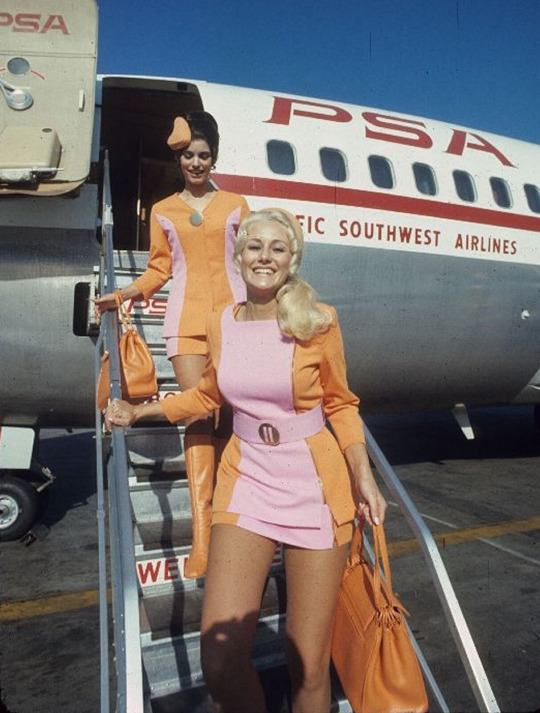
PSA stewardesses. I can't find an original source for either of these pictures, which have been widely spread without context or credit - although significant effort has been made to archive PSA's promotional content, a lot of it is, sadly, free-floating orphaned bits.
PSA's stewardesses wore bright pink and orange uniforms of miniskirts, hot pants, and go-go boots. They were encouraged to joke around with passengers, and so were the pilots. Other airlines at the time were still only slowly losing the unapproachable aura they had cultivated of stiff, sterile luxury and gravitas. PSA would get you where you needed to go without any fuss and they'd charge you half as much for it. And they weren't sloppy, either. Despite their low fares, PSA was incredibly safe, having one fatal accident in a span of time where American Airlines had 16, and even though nostalgia is obviously a factor I've only ever heard glowingly positive accounts of PSA, its service, and its staff.
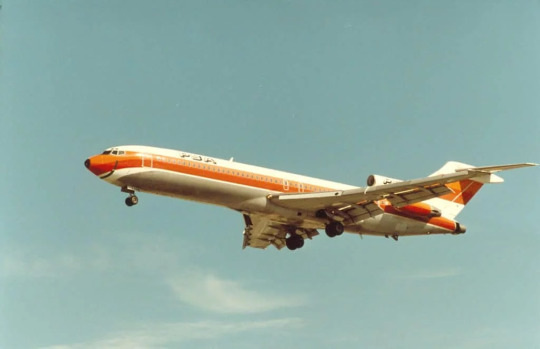
image: Bill Larkins
PSA's fleet was...eclectic. Though they operated a few very popular models, like the Boeing 727 and McDonnell Douglas MD-80 series, a lot of their offerings were somewhat uncommon. The plane in my profile picture is one of their two L-1011 TriStars, another of Lockheed's underappreciated airliners and by far the most advanced wide-body aircraft of its time. PSA was unique in that it operated a jumbo jet, their "Mother Grinningbird", on a route that was not just domestic, but intrastate. They also apparently operated a single Bell 206 helicopter, which I can find no additional clarification on. Lastly, they flew one of the oddest airliners ever built in both function and appearance, the British Aerospace 146.
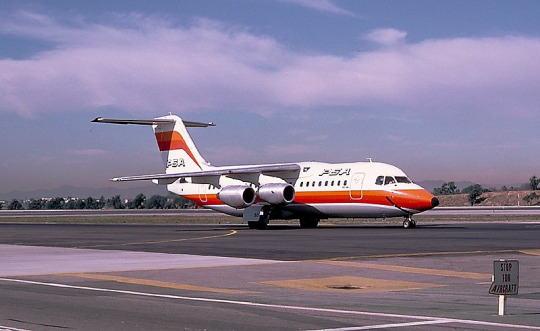
Just your regular high-wing jet. No thrust reversers necessary. Western-made but rocking the Il-76 wing anhedral. Super quiet because the powerplants are based off what you'd put on a helicopter. Seats less people than a 737-200 - six-across layout for maximum discomfort - and flies exclusively puddle jumps...yeah, I think four sounds like the right number of engines. image: Ted Quackenbush
Across all these planes, they found a livery that worked and they kept going with it. The reason this post is so long is to give context to just how important this livery is. The grinningbirds were what started low-cost carriers, paving the way for the silly names of jetBlue airplanes in a future its founders couldn't even have imagined. The shift to approachability over prestige in airline marketing was PSA's lasting gift to aviation, as were the low fares and the knowledge that a 'budget' airline didn't have to be dodgy or unpleasant - they just had to charge less than TWA and Western.
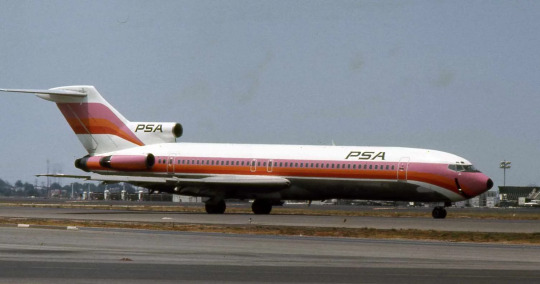
image: Piergiuliano Chesi
PSA's colorscheme was incredibly vibrant. The red and orange colors feel warm and tropical, complementing the California sunshine in which these planes spent their time. Earlier liveries also had a shocking hot pink shade above both, though it was eventually painted over due to issues with paint fading - I think the livery is vastly improved with its presence, but I suppose needs must. Despite the airline serving commuters more than vacationers it puts one in mind of things like beaches and ice cream stands - warm, high-energy things. The sorts of things one might smile about, if they like those things. I hate those things, but these planes make me like the idea of them, because they're just so darn happy to take me there!
The design of the fuselage is incredibly bold despite not using much more paint than any other airline of the day. While the striking colors definitely contribute to the overall look being more than the sum of its parts, I think there's also a few bits of clever design that really elevate the design of the plane.

The tail has a design almost like an inverse hockey-stick. Instead of following the cheatlines for maximum sleekness it chooses to diverge from it, creating a sharp angle that keeps the aerodynamic feeling while feeling fresh from similar designs of the time. By having the thin line from the tail trailing down towards the fuselage it prevents the block of empty space on a regular hockey-stick livery, where the forward portion of the empennage is fully unpainted, and creates a feeling of continuous color and excitement while keeping some staccato punch.
Similarly subtle yet effective are the stripes themselves. They aren't of an equal width - rather, the red stripe is thinner than the orange one, and in planes with the additional pink stripe this one is even wider. It feels a lot more dynamic than simple even-width stripes, feeling almost as if you can see the colors start to mix into each other. The 'mixing' feeling is helped by the fact that the cheatlines wrap under the nose instead of simply ending where they meet. The small painted white line under the main colored ones, above the unpainted metal of the underbelly, creates basically an extra two stripes for the price of one despite being so subtle many people probably didn't notice it.
On its own, the design of the bodies of PSA planes is already good, but it practically ceases to matter when you get to the face.


The way the top line of color wraps around the back of the cockpit windows makes it look almost like the plane is wearing sunglasses. And then there's the little painted black nose and, of course, the huge ear-to-ear grin. I don't really know what else to say about this because it's all been said time and time again.
I genuinely don't know how else to express it. PSA's livery was gorgeous and it was perfect for PSA. In all honesty, I don't think it's possible to improve it at all. My one slight criticism is that the actual PSA wordmark, though designed well, is a bit small and out of the way, but to be totally honest it's barely necessary. You see the smile and you know exactly who that plane is flying for.
PSA gets a PSA+.
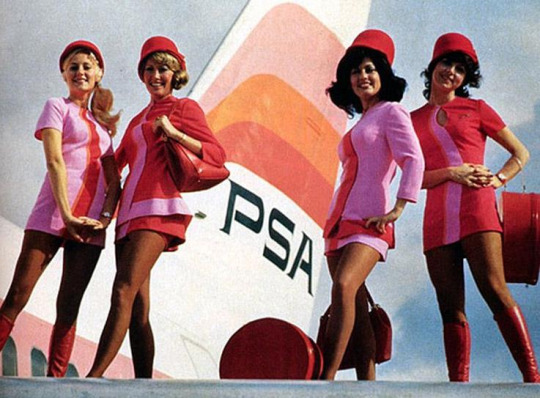
So what happened to PSA, if they were so successful? Did an economic shift catch them off-guard? Did some demographic evolution rob them of their old customer-base? Did a change of management result in a new owner running the airline into the ground? Did it have anything to do with the fact that the one time they were involved in an accident it spent eight months as the deadliest crash in US history?
Nope. They got bought out by USAir because they wanted more routes on the West Coast.
Yeah. That's the story. Neither a bang nor a whimper. They left one morning and didn't come back. That was the end of PSA, the first-ever low-cost carrier, California's most beloved airline, and one of the best-designed liveries in airline history if not the very best.
There is, however, one final twist. USAir eventually was sucked into the gaping maw of American Airlines. With this merger American Airlines also inherited the rights to PSA's IP. In classic fashion, they created a wholly-owned subsidiary by the name of PSA Airlines, just to make sure nobody else could get the trademark.
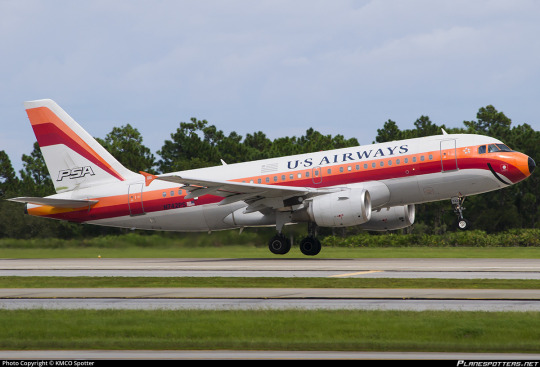
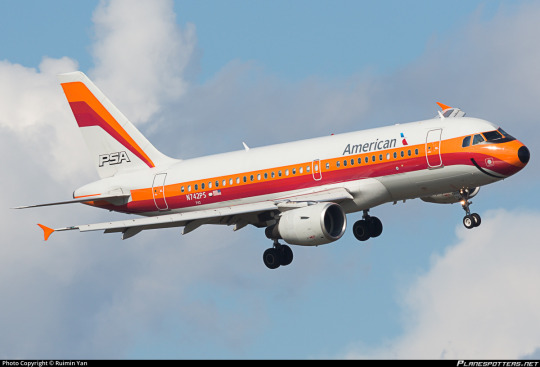
Under the iron fist of first US Airways (USAir's eventual rebrand) and later American Airlines, we were allowed one last grinningbird - an Airbus A319-100 registered N742PS. It's strange, seeing the PSA livery on a model of airplane they never operated. It's a rare example of the design on airframes that have that rather distinct 'default' modern empennage, all sharp and tall with no t-tail or third engine. The implementation could take some notes and the colors look bizarrely plastic, but I will never stop loving her no matter how much they take from her. How could I not, with that smile?
Unfortunately, in April of this year she was re-painted to a standard American Airlines livery. Although the Allegheny and Piedmont heritage liveries were removed at the same time, I almost don't even notice their absence because of the loss of our very last holdout from a much more colorful time and place. Part of me feels a sort of ripping-the-bandaid-off relief at it. American Airlines shouldn't get to parade around the skin of a much better livery worn by a much better airline. That isn't theirs; they didn't earn it. And there's no way to rebuild PSA now that times have changed and the industry is unrecognizable from the days when a ticket from San Diego to Burbank cost $9.99. All the same, the loss of yet another smile hurts. There's no way it wouldn't. And at the end of the day it makes me feel a little dead inside just imagining the mindset of the American Airlines executive who walked by her in the hangar and instead of smiling back gave the order to paint her white. And that day, the sky got a little less colorful and a lot sadder.
Maybe, in a strange sense, the way it happened is better. Nobody ran PSA into the ground. They did not cause some sort of reputation-ruining accident through willful negligence. Their customer service did not decline until they were widely grumbled about. They didn't die infamous for poor safety and loose morals like Pan Am, or splitting at the seams and betraying their reputation like Chalk's Ocean Airways. No, I don't think an organic shriveled going-under would have held any more dignity than this. I think the ending PSA got is as graceful as the ending to something like PSA could be. There is no end to the glory days which forces itself into our memories. There is no decline. No sunset to fly off into. There is a loss to mourn, but no accompanying moment to curse. Lost at sea, ship never found, nothing to imply a terrible fate; all we know is the poor sailors aren't here anymore.
Maybe it's not universally known to people who aren't interested in subjects that bring them close to it, but to those of us who love planes PSA is truly special. Its quiet apotheosis has made it synonymous with the very best an airline could be. The joy of a time where a regular person could finally afford their first plane ticket and be greeted by colorful people who talk to them like friends, where even the planes are smiling, is encoded into the DNA of PSA's remnants, into every anecdote told by an aging former stewardess and into every Polaroid taken of one of those smiling planes parked on a sunny California tarmac. It was there, and then it was a distant echo of warm breezes and idle chatter that feels almost close enough to reach out and touch. PSA never died. One day it was flying passengers to their destinations, planes smiling their same smiles. The next day it was fond memory, already graduated to the distant sunny shores of nostalgia.
youtube

#tarmac fashion week#grade: a+#region: north america#region: united states#era: 1960s#era: 1970s#era: 1980s#pacific southwest airlines#requests#defunct airlines#regional airlines#double sunrise#long haul#galley gala
106 notes
·
View notes
Text
In one sense there is nothing remarkable in observing that capitalists would prefer individuals who agree to work and consume in ways that most advantage capital. We need only to consider the ravages of the subprime mortgage industry that helped trigger the great financial crisis of 2008 or the daily insults to human autonomy at the hands of countless industries from airlines to insurance for plentiful examples of this plain fact. However, it would be dangerous to nurse the notion that today’s surveillance capitalists simply represent more of the same. This structural requirement of economies of action turns the means of behavioural modification into an engine of growth. At no other time in history have private corporations of unprecedented wealth and power enjoyed the free exercise of economies of action supported by a pervasive global architecture of ubiquitous computational knowledge and control constructed and maintained by all the advanced scientific know-how that money can buy. Most pointedly, Facebook’s declaration of experimental authority claims surveillance capitalists’ prerogatives over the future course of others’ behaviour. In declaring the right to modify human action secretly and for profit, surveillance capitalism effectively exiles us from our own behaviour, shifting the locus of control over the future tense from “I will” to “You will.” Each one of us may follow a distinct path, but economies of action ensure that the path is already shaped by surveillance capitalism’s economic imperatives. The struggle for power and control in society is no longer associated with the hidden facts of class and its relationship to production but rather by the hidden facts of automated engineered behaviour modification.
Shoshana Zuboff, The Age of Surveillance Capitalism
51 notes
·
View notes
Text
great labour history here
transcript below
I am mildly obsessed with these moments in history - specifically, sports history - when somebody looks at the way everybody is doing something and says, but, wait a second. What if I tried it this totally unexpected other way?
You know, famously, in high jump, a guy named Dick Fosbury started jumping over the bar backwards, and it was so effective that now everyone does it.
Or in baseball - at some point, a very clever player was like, what if instead of swinging at a fast-moving ball - what if I just hold the bat up to where the ball is going to be and (clicks tongue) knock it frustratingly into the infield? And the bunt is born. Love the bunt.
And look, I'm obsessed with these moments because it forces everyone to be like, wait a second. Can they do that? That can't be legal. But yeah, it is, and the game is changed forever.
NICK FOUNTAIN, HOST:
And Kenny, of course, these moments don't just happen in sporting competition. They happen in our world, too - the world of economics and business. And there is an example that has become particularly relevant right now.
MALONE: Yeah, so we're in the middle of what people have been calling hot labor summer. I guess it's turned into, I don't know, unseasonably warm labor fall or whatever.
FOUNTAIN: (Laughter).
MALONE: But yes, we are seeing this spate of labor actions across the country - strikes in Hollywood, at hospitals and schools, at car factories.
FOUNTAIN: And, you know, strikes are not so different from sports. They both have chanting and people holding up punny signs. But more importantly, they also have competing teams employing tactics and countertactics and counter-countertactics.
MALONE: In other words, labor is kind of exactly the right kind of situation for the right person to come along and jump backwards over the way things are supposed to work and change labor disputes forever.
(SOUNDBITE OF ANTOINE BRUNO FREDERIQUE BLANC, JAMES PATRICK KALETH AND MAX BRONCO'S "TAKE ME BACK AGAIN")
MALONE: Hello, and welcome to PLANET MONEY. I'm Kenny Malone.
FOUNTAIN: And I'm Nick Fountain. And if you had to pick a Fosbury flop, bunt moment in labor history, a decent candidate might be what happened 30 years ago when one airline went to war with a group of scrappy flight attendants.
MALONE: Today on the show, the story of what happened when a union figured out how to strike without really going on strike. It seemed too good to be true. There were legal challenges. There were shady flights to Guadalajara. And arguably, it's a case study that is still shaping the labor disputes we see today.
(SOUNDBITE OF ANTOINE BRUNO FREDERIQUE BLANC, JAMES PATRICK KALETH AND MAX BRONCO'S "TAKE ME BACK AGAIN")
MALONE: Before we get into our story, you have to understand this enormous threat that has been hanging over airline unions for the last 3 1/2 decades.
FOUNTAIN: Yeah, we're going to call it the TWA threat because, in 1986, the flight attendants for Trans World Airlines, also known as TWA, were in a labor dispute with their airline. And it was looking like they were going to have to strike.
MALONE: And, you know, the thing about a strike is if you generally follow all the rules and the letter of the law, the government protects that labor action. Like, you are not allowed to be fired when you're striking. That's the deal. So great - the TWA flight attendants went on strike.
FOUNTAIN: But what was so notable about what happened in 1986 is that TWA found a legal workaround - a way to effectively fire all those striking flight attendants without technically firing anyone.
MALONE: Yeah, apparently, when a flight attendant walked off the job - went on strike - it was legal for TWA to fill that newly vacated position. TWA wasn't actually firing anyone, but the flight attendant that went on strike - well, they would have to wait until another position opened up. And, of course, until that happened, that flight attendant was functionally fired. They weren't working. They weren't earning a paycheck.
FOUNTAIN: And the TWA move in 1986 was to do this on a massive scale. When the flight attendants went on strike, the company started replacing them - thousands of people. It would take years before a new TWA job would open up for most of them.
DAVID BORER: And they were all replaced by scabs. The sanitized term for it is permanent replacements.
MALONE: But you're a labor lawyer, so...
BORER: Right.
MALONE: ...You call them scabs, sure.
BORER: That's right.
MALONE: This is longtime labor lawyer David Borer.
BORER: It was horrifying. And, you know, you look at that and you think, oh, my gosh, we can't ever let this happen again.
MALONE: David was watching this TWA fiasco carefully because back then, he was just starting out as the union lawyer for a different group of flight attendants, which included the ones that our story is about today, the flight attendants of Alaska Airlines.
(SOUNDBITE OF ARCHIVED RECORDING)
UNIDENTIFIED NARRATOR: At Alaska Airlines, we discount fares, but we never discount service.
(SOUNDBITE OF MUSIC)
FOUNTAIN: Ba, ba, ba, ba-bum. Ba-bum, ba-bum.
So we pick up a handful of years after the TWA stuff. It's 1993. David was negotiating the new contract for those Alaska Airlines flight attendants.
MALONE: And David says, negotiations were not going very well. And so he and the flight attendants, they had started meeting to discuss what to do next.
BORER: We spent the better part of a week talking about strategy. And we knew the guiding thing behind all of it was, we can't do what the TWA flight attendants did.
MALONE: Right, because now all of the airlines have the TWA playbook. So if your flight attendants go on strike, you just use the old TWA move and replace those pesky strikers.
FOUNTAIN: One of the people David was strategizing with...
GAIL BIGELOW: Good morning, Nick. It's Gail Bigelow.
FOUNTAIN: Gail Bigelow was an Alaska Airlines flight attendant and one of the union's lead negotiators. And she says, this contract negotiation time, it was tense. Alaska Airlines was a small-ish company. And suddenly, not everyone was on the same side.
BIGELOW: And so they had their people who were either married to or friends with or whatever from different departments, and so they were getting information. I'm sure they weren't...
FOUNTAIN: Ooh, there were spies in your ranks.
BIGELOW: There were spies in the ranks. Yes, indeed.
MALONE: To avoid spies, David and Gail had started to hold secret strategy meetings. And really, the focus was trying to find a way around this sort of impossible problem, which was, if the flight attendants go on strike, Alaska Airlines is just going to use the TWA strategy and replace all of the flight attendants. David says they knew they needed a counterstrategy.
BORER: Of course. Sun Tzu says you don't attack your opponents directly, you attack their strategy.
MALONE: Were you literally the guy quoting Sun Tzu's "The Art Of War" at the union organizing meeting?
BORER: Oh, yeah.
MALONE: (Laughter).
BORER: Call me crazy, but, I mean, there's a lot in there. This idea of attacking their strategy was, like, directly applicable.
MALONE: Attack the airline's strategy. Now, remember, the TWA move was to effectively fire everyone without technically firing anyone. Well, David and Gail thought, what if there is a way for us to effectively go on strike without actually going on strike?
FOUNTAIN: In other words, what if they could create the impact of a strike without the risk of a strike? On June 19, 1993, the union calls a press conference.
MARY JO MANZANARES: There's a bunch of chairs. There are people in chairs. There are cameras.
FOUNTAIN: Mary Jo Manzanares was acting as a union spokesperson at that press conference.
MARY JO: There are print reporters, there's television reporters. The big question, of course, was, what were we going to do next?
MALONE: What were they going to do next? And if you were one of the reporters there, it was totally reasonable to expect the big announcement to be the Alaska flight attendants are going on strike. But what happens instead is pretty incredible. Mary Jo walks up to the microphone and basically says, we are not going on strike yet. We will strike, but we aren't telling anyone any of the details.
FOUNTAIN: Here's Mary Jo making the announcement back then.
(SOUNDBITE OF ARCHIVED RECORDING)
MARY JO: So where do we strike, when do we strike, what do we strike? I don't know, and none of you know. And none of management knows. And none of the traveling public knows.
MALONE: The union's thinking was that Alaska Airlines couldn't replace the striking flight attendants if they weren't actually striking yet.
FOUNTAIN: And yet, the announcement made that threat of a strike very real. Mary Jo was at the podium saying that they could strike at any moment on any flight.
MALONE: She told the crowd of reporters that the union was calling this strategy CHAOS, which she was quick to point out was an acronym.
(SOUNDBITE OF ARCHIVED RECORDING)
MARY JO: Create havoc around our system.
MALONE: Create havoc around our system. And you can think of the CHAOS strategy as, like, guerilla warfare. You know, when you're up against a bigger, more powerful opponent, you keep them scrambling. You carefully pick the moment you're going to attack. Hopefully, that forces your opponent to prepare for anything and everything constantly.
FOUNTAIN: And you know who loves a good guerilla warfare, airline chaos story?
(SOUNDBITE OF ARCHIVED RECORDING)
UNIDENTIFIED ANNOUNCER: Now, live at 11 o'clock, KOMO News 4.
UNIDENTIFIED REPORTER #1: Good evening, everyone. If you fly Alaska Airlines, a labor dispute might affect your travel plans.
FOUNTAIN: The television news.
(SOUNDBITE OF ARCHIVED RECORDING)
UNIDENTIFIED REPORTER #1: Alaska flight attendants are threatening to create chaos this summer for passengers aboard the airline.
MALONE: Yeah. I mean, this was made-for-TV-news stuff. What's a better story than CHAOS in the skies, or pay us or CHAOS?
(SOUNDBITE OF ARCHIVED RECORDING)
UNIDENTIFIED REPORTER #2: We just don't know when this stoppage or slowdown or disruption of service is going to occur, but it could happen literally any moment, David (ph).
UNIDENTIFIED REPORTER #3: And of course, that's the tactic of the flight attendants, is not to let anybody know, that threat that something might happen at some time. Has it had any effect on bookings by the airline?
UNIDENTIFIED REPORTER #2: As a matter of fact, it has. The company wouldn't get into specifics, give us absolute numbers, but they did concede today that, yes, the number of bookings is down because of this.
MALONE: Yes, the bookings were going down, and this was key. The union was basically getting the benefits of a strike without suffering the consequences.
FOUNTAIN: Right 'cause if you think about the way a normal strike works, it's all about inflicting economic harm on your opponent. So, like, the company won't make any money because their workers have walked off the job, but also, those workers aren't getting paid either. Normally, both sides are taking the financial hit.
MALONE: But with the flight attendants here, their airline was losing bookings because of the strike threat. And yet, the Alaska flight attendants weren't actually striking yet, so Alaska still had to pay them. And if CHAOS was the strategy, flight attendant and union negotiator Gail Bigelow says it was working better than she had ever expected.
BIGELOW: I had people calling me at my home saying, oh, I have tickets to take my kids to Disneyland. Please don't strike my flight. I mean, people I barely knew. And...
(LAUGHTER)
BIGELOW: ...So it was working.
FOUNTAIN: CHAOS was working. No one knew what would happen next, says union lawyer David Borer.
BORER: And that was part of the strategy - was to keep them guessing. Sun Tzu - to go back to Sun Tzu - says a confused enemy is easily defeated. I know it's corny and everything, but strikes are so much like warfare that it's actually directly applicable.
FOUNTAIN: Now, this whole not striking but threatening to strike thing - this was just phase one of the CHAOS strategy because the union knew this phase could only last so long. Like, eventually they would become the flight attendants who cried strike over and over, and people would stop taking their threat seriously. Phase two of CHAOS was coming - a real strike somewhere, sometime, just eventually.
MALONE: In the meantime, Alaska Airlines - they were preparing for that moment. Greg Witter was a spokesperson for Alaska Airlines at the time, and he was in the boardroom helping to figure out Alaska's plan, their countermove, for when those strikes finally did begin.
GREG WITTER: In preparation for the fact that there could be a strike, all the management personnel were trained as flight attendants so that if there is...
MALONE: Including you?
WITTER: Including me. Yep. Yeah, I went off to three weeks of flight attendant training.
MALONE: Tell me about going to flight attendant school. Yeah.
WITTER: Oh, very intense.
MALONE: Intense because, of course, being a flight attendant is so much more than safety demos and handing out little bags of pretzels or whatever.
FOUNTAIN: Yeah. Greg says he had to practice for an emergency landing, pass a pretty rigorous swim test, memorize a phonebook-size safety manual.
WITTER: You've got to learn, basically, every inch of every aircraft you fly. You got to know the least-risk bomb location and...
FOUNTAIN: The what?
WITTER: Latches for this - oh, the least-risk bomb location. So if someone on the plane says they've got a bomb in the bag, and you're able to wrest that bag away from them, where can you put that bomb on the aircraft where it would do the least damage if it went off.
FOUNTAIN: That's a thing? What?
WITTER: That is the thing. Absolutely. The least-risk bomb location - absolutely a thing.
MALONE: And what is the least-risk bomb location? I mean, should we even tell people this, Nick? Is this dangerous information?
FOUNTAIN: It's helpful information.
MALONE: OK, OK. Greg says it's usually behind the engine. Least-risk bomb location - behind the engine. There you go.
FOUNTAIN: So Alaska was training people like Greg, the press guy, and hundreds of other manager types not to become full-time replacements, but as stopgap attendants for the moment the union finally started to strike.
MALONE: Yeah, right because Alaska Airlines was worried about the strike starting, like, in the middle of the flight or something. And so they actually started booking seats for Greg and this crew of managers trained to be flight attendants onto as many flights as possible. You know, that way, if the strike did start mid-flight, one of those people could jump up and suddenly become a flight attendant.
FOUNTAIN: Greg says he was assigned to literally just sit on the flight from Seattle to Guadalajara, Mexico, over and over again. At one point, he says, he even got pulled aside by the Mexican authorities.
WITTER: I just - I remember my heart was pounding when they hauled me into the backroom. And I thought, oh, my God, I know exactly what they're thinking here. And I presume they thought I was a drug mule of some kind.
FOUNTAIN: Sure.
WITTER: Like, who's this guy that keeps flying from Seattle to Guadalajara every four days, you know?
MALONE: Now, having Greg and lots of other management people flying around and sitting at airports - this was just a way to temporarily keep flights going when the big strike eventually did happen.
FOUNTAIN: But Alaska's bigger move was going to be the TWA strategy. As soon as the attendants walked off the job, Alaska could replace them with an army of new flight attendants.
MALONE: Of course, Alaska had to hire that army. They had to find a whole new workforce. And so Alaska held a giant job fair - even sent their assistant vice president of employee relations to this thing.
(SOUNDBITE OF ARCHIVED RECORDING)
UNIDENTIFIED PERSON #1: We are going through the selection process to put people into training for future openings. And, of course...
MALONE: This, by the way, is the weirdest job fair I have ever heard about. For one, remember, Alaska didn't have any jobs to fill yet since no one was striking yet. But also, there are people picketing the job fair, and reporters are asking the job fair attendees basically, like, hey, don't you feel bad signing up to take a job from someone who's going to go on strike?
(SOUNDBITE OF ARCHIVED RECORDING)
UNIDENTIFIED PERSON #2: I'm not worried about them. I got a wife and kids to support. You know, that's their problem.
UNIDENTIFIED PERSON #3: I don't know them, so - if I knew them personally, it'd probably hurt. But I don't, so it doesn't bother me.
FOUNTAIN: OK, so our two sides have their strategies. The flight attendants have CHAOS, their constant strike threat without actually striking yet.
MALONE: And then, Alaska is preparing for the moment that flight attendants finally do strike, preparing to go full TWA, hiring their army of replacements.
After the break, the strike begins.
(SOUNDBITE OF MUSIC)
MALONE: The CHAOS campaign had two phases - phase one, threaten to strike at any moment and then phase two, actually strike, actually have flight attendants walk off the job.
FOUNTAIN: Two months into the campaign, they decided it was time to move into phase two. Gail Bigelow had been collecting the names of her fellow flight attendants who were willing to walk off the job, and they got put on what she called the Guts List.
BIGELOW: They'd have the guts to do it, yes. It was - that's the Guts List.
FOUNTAIN: 'Cause going on strike as a flight attendant very likely meant getting permanently replaced, you know, because of the looming TWA strategy.
BIGELOW: Well, it was frightening for me because I was in a position to try to encourage the flight attendants to strike.
FOUNTAIN: You were asking them to make a - take a crazy risk. They might all lose their jobs.
BIGELOW: It was a crazy risk, yes.
MALONE: It was also this huge puzzle for the flight attendants. Phase two of CHAOS meant actually going on strike. And yet, the moment a flight attendant walked off the job, Alaska was allowed to replace them, pull the old TWA move.
FOUNTAIN: Gail and the union team thought they just might have discovered a way around this, a way to strike without getting replaced.
MALONE: Yeah, it was a very clever, very chaotic kind of countermove to the entire TWA strategy, but they couldn't be sure that it would work until they actually tried it.
FOUNTAIN: The moment of truth came on August 20, 1993, and the whole thing unfolded like a SEAL Team Six mission or something.
MALONE: The target? A fully booked 6 p.m. flight leaving out of Alaska's hub in Seattle. That flight had a crew who had signed up for the Guts List.
FOUNTAIN: One of those flight attendants was Jennifer Price. She says it was a seemingly normal day. She was at the airport when a union official walked up to her and said...
JENNIFER PRICE: OK, Jennifer, we've chosen your crew. You will be striking your flight.
MALONE: Jennifer calmly gets on the plane, stows her baggage, does the preflight checks.
FOUNTAIN: She's there with her fellow flight attendants, Chris (ph) and Barb (ph).
PRICE: The boarding agent came down to the plane and said, are you ready to board? And Barb said, no, we are not ready to board. On the advice of our union, we're engaging in strike action, and we won't be available to perform our work assignment (laughter). And you could see the agent's eyes getting bigger. And then she said, you're kidding. No, I'm not. And we grabbed our suitcases and walked off the airplane.
MALONE: Jennifer and her crew walked past the passengers who were all ready to board. She says they looked confused. They looked like they were getting worried.
FOUNTAIN: And at this exact moment, Gail Bigelow, who's back at strike headquarters, sends a fax to Alaska Airlines saying, we are writing to inform you that we are striking this one flight, Flight 536 out of Seattle's airport.
MALONE: There it was. The strike had officially begun. Yes, it was just one flight crew on one flight. But this was the moment Alaska Airlines had been preparing for.
FOUNTAIN: Yeah, an emergency team of those managers that were trained to be flight attendants jumps into action to sub in for that striking flight crew.
MALONE: But of course, the bigger Alaska strategy was the TWA strategy. As long as Jennifer and her crew were on strike, Alaska was allowed to permanently fill the positions they just walked out on - to effectively fire Jennifer while she's on strike.
FOUNTAIN: But after just 28 minutes of the strike, Gail Bigelow sends a second fax to Alaska Airlines saying, actually, strike's over now.
MALONE: And here's why that is a genius move. Alaska hadn't actually managed to get the paperwork together or whatever it would take to permanently replace Jennifer's flight crew during that 28-minute strike window. That crew was no longer on strike, and so the union was pretty sure Jennifer's group of attendants was now safe from getting TWAed (ph), from getting replaced. Here's Gail Bigelow again.
BIGELOW: The three of them came back to strike headquarters then. And I can remember the picture of them, and they were all very relieved to be in strike headquarters, knowing that they were going to get their jobs back.
MALONE: Flight attendant Jennifer Price remembers that moment - walking back into headquarters that night.
PRICE: Oh, yeah, they cheered. We were the heroes of the day. It was - you know, that was helpful (laughter).
FOUNTAIN: The kind of strike that happened that night, it has a technical name. It's called intermittent striking.
MALONE: Yeah. You know, the idea is instead of everyone going on strike and then staying on strike, you do a bunch of little strikes. In this case, you strike one flight at a time and just for a tiny window of time. And the union was hoping that this would make it incredibly hard for Alaska to actually catch and permanently replace attendants while they were on strike.
FOUNTAIN: And the flight attendants kept attacking this way. Four days later, they struck a flight out of Vegas, then hit five Bay Area flights on the same day.
MALONE: And it was chaos every time this happened. Alaska had to scramble to get their managers onto these flights as flight attendants. Alaska spokesperson Greg Witter remembers being at Seattle's airport when somebody from his company comes, like, running up to him.
WITTER: We have a walk-off. And it was me and two guys from marketing. We were hailed. You guys got to go work a flight. Oh, my God. All three of us - the blood drained out of our faces.
FOUNTAIN: So Greg rushes to get on the flight, and then he realizes he's going to have to give the iconic safety demo.
WITTER: My heart literally was about coming through my throat while I'm doing this safety demonstration. I had cold sweats. Oh, my God. My palms were all sweaty and clammy. It was terrible.
FOUNTAIN: How many flights do you think you did that day?
WITTER: One, two, three. God, I think probably at least three until we got to fly home.
FOUNTAIN: Greg can't exactly remember because it was a total mess. It was clearly an unsustainable solution for Alaska, and it had been just three weeks of this intermittent striking.
MALONE: In the end, here is how this whole tactic-countertactic battle wound down. In what feels a little like an act of desperation, Alaska Airlines said, you know what? We think this intermittent striking thing - we think it's actually not allowed. So forget being replaced. If you do this, you're going to get straight-up fired. The union took Alaska Airlines to court, and the court sided with the union. They said intermittent striking is protected by law.
FOUNTAIN: And the union's like, OK then. We're going to keep doing these intermittent strikes until we get a decent contract. Less than two weeks later, Alaska proposed what Gail thought was pretty decent contract.
MALONE: Gail had been at this for more than three years, and just like that, it was over.
BIGELOW: I was like, oh, my gosh. I have my life back (laughter). I mean, really, that's how I felt. I have my life back. But I - but in seriousness, I felt really good about it. I felt the contract was a good contract.
MALONE: David Borer, the Sun-Tzu-quoting lawyer, agrees. He says the new contract was phenomenal for the flight attendants.
FOUNTAIN: So it was a great victory in your head.
BORER: Yeah, like the poster on my wall, total victory. No, I mean, we didn't lose a single job. Nobody who struck lost any income. And we got a contract with a 60% raise that we hadn't even asked for.
FOUNTAIN: David thinks it was the most successful labor strike of a generation. And he says the CHAOS strategy has kept working for the union. Since that Alaska flight, not a single flight attendant from David's union has had to strike in the U.S. The mere threat of CHAOS has been enough.
MALONE: And I suppose it is reasonable at this point to then wonder, why doesn't every strike use this exact same CHAOS playbook? It seems like the obvious thing to do.
FOUNTAIN: Well, the answer to that one is a little in the weeds. So airline strikes and, actually, railroad strikes, too, have one set of rules. But most other strikes are governed by a different set of rules. And those rules don't allow for this kind of intermittent on-again, off-again striking.
MALONE: Yeah. So for instance, we've got this United Auto Workers strike happening right now. Once the UAW announces, for example, that the Ford assembly plant in Wayne, Mich., is now on strike, well, those workers are going to need to be on strike until the dispute is over. They're not allowed to 20 minutes later, say, oh, hey, never mind. This plant's strike is over.
FOUNTAIN: But what has been really interesting to watch are the ways that the UAW and their president, Shawn Fain, do really seem to be introducing CHAOS where they're allowed to. Attorney David Borer has noticed this too.
BORER: Nobody's asking Shawn Fain, oh, how long do you think you can hold out? They're all saying, oh, when are you going to strike the next plant? And that's exactly how it was with Alaska.
FOUNTAIN: Right. Because what the UAW has done is start by striking at three auto factories, and then it has added a strike at a factory somewhere else, and then at somewhere else and then somewhere else. The rhythm of this UAW strike is sounding a lot like the CHAOS strike from 30 years ago.
MALONE: Yeah, it's funny. I was driving to work the other day and heard a report from our colleague Camila Domonoske about the UAW strike. Here, we'll play a little bit of it for you.
(SOUNDBITE OF ARCHIVED NPR BROADCAST)
CAMILA DOMONOSKE: No one knows how long these strikes will last or what kinds of locations could be targeted next or even which companies. The union has said...
MALONE: So, yeah, I heard that. And I just thought, like, wow, that sounds so similar to that wild press conference 30 years ago when the Alaska flight attendants first introduced CHAOS to the world of labor.
(SOUNDBITE OF ARCHIVED RECORDING)
UNIDENTIFIED PERSON #4: So where do we strike? When do we strike? What do we strike? I don't know, and none of you know, and none of management knows and none of the traveling public knows.
(SOUNDBITE OF LUNA CITIES' "BELIEVE")
FOUNTAIN: You can email us at [email protected], or you can find us on TikTok, Facebook or Instagram. We're @planetmoney.
MALONE: Our show today was produced by Sam Yellowhorse Kesler with help from Dave Blanchard and Willa Rubin. It was edited by Jess Jiang and fact-checked by Sierra Juarez. It was mastered by Hans Copeland. Ayda Pourasad helped with research. Alex Goldmark is our executive producer.
FOUNTAIN: Shout-out to the Wall Street Journal reporters Nora Eckert, Mike Colias and Ryan Felton, whose mention of the CHAOS strategy in an article about the UAW's present strategy turned us on to the story. I'm Nick Fountain.
MALONE: I'm Kenny Malone. This is NPR. Thanks for listening.
20 notes
·
View notes
Text
I turn up last night at the Chabad rabbi’s house. There’s security cameras everywhere, Securitas stickers in the window. I wonder if they’ve ever had to press their panic button.
As I’m waiting for someone to come to the door, another guest arrives. He’s about my age, upsettingly handsome, and Israeli. I tell him it’s my first ever Shabbat, and he says he’ll talk me through everything as we go along.
The rabbi’s wife has me braiding challah alongside her 10 year old daughter and the Israeli. I think about how many generations back it was that someone from my family did this.
More people arrive. A tourist couple, a middle aged husband and wife from America. We chat about where they’ve been so far and joke about how bad Olafsvík smells because of the dried fish factory there.
Next is some young Haredi guys. I wonder how walking around Iceland dressed as they dress has been for them, if anyone has harassed them. We chat about where we’ve been in the world and why they came to Iceland (they’re in yeshiva in New York, they saw cheap flights on an Icelandic budget airline and thought why the hell not).
More people trickle in. Some American students, freshly graduated (did they get screamed at by their peers? Were they allowed to move freely around campus?).
A Ukrainian refugee, her family’s from the same area as the American guy’s family. His grandma was the only survivor of a pogrom, hers one of the only survivors of the holocaust.
Then the rabbi comes, and the Israeli guy hands me a siddur and in a low voice explains to me what to do, what to read. Says it’s no pressure, Chabad prayers can be quite a lot. I’m standing to one side because I feel like I’m not allowed to be fully involved, new to this as I am, but one of rabbi’s kids is running around so we move into the group that’s gathered around the little alter (it bothers me that I don’t know the name of this, or the words everyone else is singing and chanting and mumbling). I feel something land on the back of my head - as he’s rocking and praying, the rabbi has grabbed a kippah from the pile on the table and plopped it on my head.
Prayers end, I still have no idea what was going on but I felt something all the same. We sit to eat, and I’m next to the Israeli, who’s next to the rabbi. As the rabbi says prayers in Hebrew, his wife opposite me explains quietly what’s going on. When it comes time to wash our hands, she teaches me how to say the blessing.
The food is amazing. Hummus and tagine and soup and all sorts of other bits and pieces. The challah I braided is soft and fluffy, and even tastier when it’s soaked up a little of the baba ganoush and olive oil on my plate. I think about how if I tell my friends what sort of dishes were served here, the words “cultural appropriation” might come up.
I talk to everyone at some point or another. The Israeli guy is here working in the tourist industry, the rabbi’s wife has British family and grew up in a Nordic country. The American guy is a doctor at a teaching hospital near a campus, he’s had people picket his hospital.
The graduate women are laughing at Iceland having a TGI Fridays in between casually talking about other students throwing things at them.
At one point, some asks me what my first Shabbat has been like for me, and I say it feels like coming home. The Israeli puts his arm around me and says “welcome back, brother”. The Haredi guys tell me that a Jewish life is a joyous life.
I take off my new kippah and put it in my pocket when I leave.
And then today. I arrive for morning prayers, I meet new people, the rabbi’s toddler son clings to my leg as his wife makes me a coffee while explaining how that’s done on Shabbat. Her grandma converted at 18, her grandfather was a secular son of survivors who became religious again after meeting her. She told a story last night about her grandfather, an elderly and highly esteemed professor of history who refuses to retire, having someone get up in his face while he was getting the bus home and pointing their phone camera at his face.
The Israeli guy had to head back to where he lives (also out in the country, not far from me by Icelandic standards) so he’s not here today, but there’s my Haredi friends from last night, as well as some new people. An American who’s been here since the 80s, a European guy (Spanish, I think I heard him say, and I wonder if my possibly Sephardic family and his may have known each other half a millennia ago), and all of the rabbi’s kids are awake. They’d flown in from Sweden yesterday morning so most of them were asleep.
There’s prayers again, I don’t know what’s being said, I am only vaguely following along in the Siddur. Most of the men rock and sway as they pray, I’m aware of this being a thing Jews do but not why. I add it to my ever growing mental list of things to look up later. I feel my body want to join in, but I feel like I’m not allowed.
The Torah portion this week is from Leviticus, and I have a moment of being uncomfortably aware of who I am as the rabbi, albeit briefly, touches on the bit about unnatural relationships. He shook my hand, I’m included in the prayers, so they see me as a man. I’m certain they don’t know what sort of man I am. That’s a conflict with myself and this culture and religion that I’m gonna have to deal with eventually, but not now. Now, I push it aside and listen to the discussion on our obligations to each other as people, and how Torah law is similar to and differs from general Western law. I listen to the doctor talk about performing CPR on someone who he saw collapse. I wasn’t raised Christian but I still expect the words “Good Samaritan” to come up. I’m not sure how that makes me feel.
And then, more food. More food, more discussions, more people coming in. Another American who lives local, a couple I don’t get the chance to speak to, but I think at least one of them has an Icelandic accent. The rabbi’s wife points me out to people and tells them where I live. My kippah slides from my shaved head as I turn to talk to someone else, it would be embarrassing if I hadn’t seen someone else’s fall off not that long ago.
People filter out, and a group of tourists arrive. IDF guys on leave, they’ve just finished the ring road tour. We drink a toast with them. One of the Haredi guys has a young cousin who just got called up, one of the Americans has a nephew who was serving on the border when the pogrom happened. One of the Israeli guys asks me what bars I recommend in Reykjavik.
I leave when the Haredi guys do. The one I spoke to the most promised to come visit when he next comes to Iceland (it was a short trip, he wants to see more) and I wonder if he remembers me saying how there’s a guy in my town with from-the-river-to-the-sea painted on his van. The other Haredi guy says he’ll look me up on Facebook, and says he’s glad I got to see how good being Jewish can be.
I get halfway back to the bus stop before I remember to put my kippah in my pocket.
10 notes
·
View notes